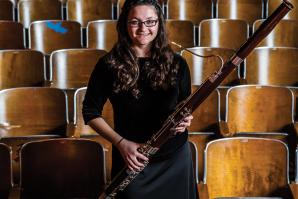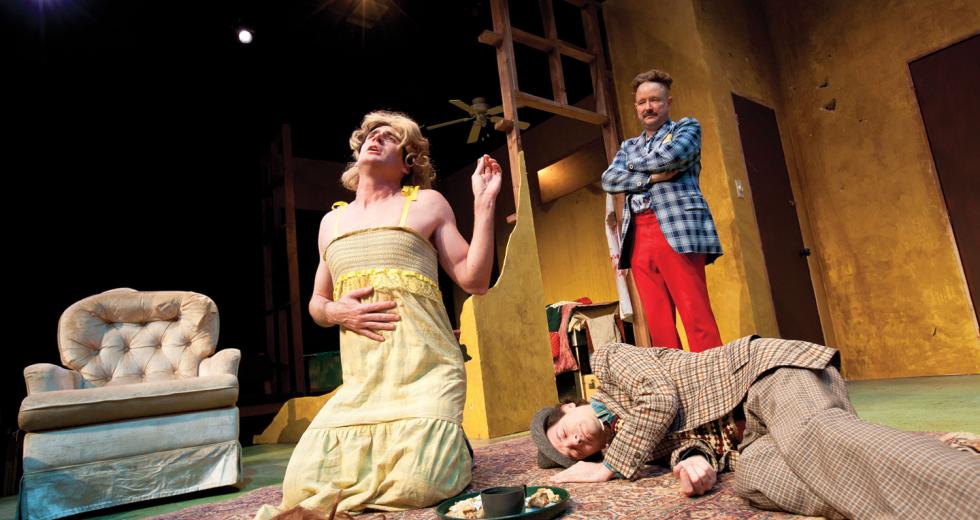Declining ticket sales and less corporate and government funding over the past four performance seasons have led many to cancel shows, host events in less-expensive venues, shorten seasons, slash budgets, lay off staff and drop ticket prices in an attempt to fill seats.
Hard times forced performance organizations to get crafty, and as a result the arts in Sacramento may never have been livelier. The Sacramento Ballet staged a flash mob on a midtown street to draw attention to its production of Dracula. B Street Theatre rolled back ticket prices to 2006 levels. And Light Opera Theatre of Sacramento experimented with selling deeply discounted tickets through Groupon.
Anything is better than an empty seat, says Phil Daley, music director and publicist for the Light Opera Theatre.
Sacramento Theatre Company, in anticipation of its October production of Frankenstein, even partnered with Golden State Donor Services to encourage organ donations.
There are a lot of possibilities. You just have to break the mold, says Jane Hill, interim executive director of the Sacramento Philharmonic Orchestra. It might be a way to reinvent, a way to create and a way to thrive, not just a way to survive.
Hill returned to the Philharmonic in July, reacquiring the
position she held from 2002 to 2007. One of her first acts this
time around was cutting the Philharmonics budget by about
$250,000, letting some employees go and reducing the 2011-2012
concert season from five performances to four.
I wouldnt say things are dire; I would say theyre challenging,
she says.
Meanwhile, Hill and Rod Gideons, general director of the Sacramento Opera Association, are considering the possibility of merging the two companies. Already they share a midtown address and in November co-produced Leoncavallos Pagliacci with the Philharmonics Michael Morgan conducting both orchestra and opera chorus.
The opera is one of the hardest-hit by the recession. Were surviving, certainly not thriving, says Gideons, now the lone full-time employee. (Our survival) depends on whether this community believes it needs an opera company, so, ultimately, its in the hands of the people.
Sacramento Opera made draconian cuts to its budget this year
after an $85,000 shortfall caused cancellation of its spring 2011
production. The operating budget two years ago was $1.6 million.
This year, it is $704,000.
An urgent plea to donors last May brought in $135,000, allowing the company to have a 2011-2012 season. Even so, the opera no longer can afford to stage three lavish productions each year. Ticket sales are down even for the most popular operas, and the cash-depleted organization has no endowment to fall back on.
We believe that the strategic alignment with the Philharmonic is
the way to go because it will increase both organizations
presence in the community, says Gideons, noting such a merger is
99 percent
assured.
After a touring hit Broadway show flopped in Sacramento last year, executives at California Musical Theatre knew they, too, needed revolutionary change, though it meant alienating some subscribers.
Sacramento has long been a two-week city for CMTs Broadway Sacramento series, until In the Heights, the 2008 Tony Award-winner for best musical, lost a whopping $300,000.
For 2010-2011, we had 11,834 subscribers, and that is not sufficient for a two-week market. It doesnt work, says CMT Executive Producer Richard Lewis. So last November after In the Heights, which was a wonderful production but lost a lot of money, we knew we had to make big changes. We decided to go back to being a one-week city.
The exception would be Wicked, which makes its Sacramento debut May 17 for a three-week stand at the Community Center Theater.
There were a number of subscribers who werent happy because it meant that some of them in the second week had good seat locations, and now I squished 11,800 (people) into eight performances instead of 16, Lewis says. Well, what happened was that 9,800 subscribers decided to renew, and only 330 opted to get refunds once they saw their new seat locations.
Then Broadway Sacramento picked up an additional 3,700 subscribers. Back on its feet and with a strong 2011-2012 season under way, Lewis now turns his attention to boosting attendance for CMTs other properties: Music Circus, a one-time tent show now at Wells Fargo Pavilion that this year celebrated its 61st summer season; and the newish Cosmopolitan Cabaret.
Music Circus had about 73 percent attendance in the past two seasons, Lewis says. Cosmopolitan Cabaret, an intimate space at 1000 K St., has operated at about 52 percent attendance since debuting with Forever Plaid in the fall of 2008 at the height of the economic meltdown.
After its disastrous financial loss with In the Heights, California Musical Theatres leadership devised an economic recovery plan. The organization received a $300,000 unsecured line of credit from the city of Sacramento and hopes never to use it.
Our expenses can fluctuate dramatically, depending on when the bills come in. And the payroll goes up and down like crazy because when youre doing a show, you have a raft of people to pay, Lewis says. As we look at our cash-flow projections, were going to come out of this OK. We thought we might need (the line of credit) in September, but it doesnt look like well need it at all this fiscal year. Its like taking an umbrella with you on a day it may rain. If you leave the umbrella at home, it surely will rain.
Sacramento Choral Society & Orchestra is unique among local performing arts organizations because its made up of 180 unpaid singers, 55 paid professional musicians and an all-volunteer operations team.
The society lost major funding this year: $114,000 in gifts and a grant. Operating on a shoestring now means everyone is responsible for keeping the lights on. Singers, for instance, are each expected to sell four to six concert tickets.
Like most arts groups, were clearly doing more with less, says society President Jim McCormick.
To get bodies in the seats at the Sacramento Ballet, longtime co-artistic director Ron Cunningham has implemented low-budget guerrilla marketing efforts.
After a downturn in the 2009 season, It looked like we were in serious trouble, and we canceled part of our season that year, he says. So we reinvented ourselves and started doing more intimate in-studio performances without the high production costs of the Community Center Theater. The troupe also put on living-sculpture performances in the community for free or donations.
We turned around a situation that looked like we were in peril of perhaps going out of business to finish the season in the black, and we managed to maintain all of our dancers without layoffs, Cunningham says. It was kind of a miracle.
Not willing to stand idly on their toe-shoes, the dancers themselves established a website for donations and lobbied businesses for support, which garnered considerable media attention. The dancers kept Sacramento Ballet visible in the community, even as the company canceled its last three productions of the 2008-2009 season.
Now, Cunningham says, Were cautiously optimistic, as are most nonprofit organizations. Everybody tries to do the best they can with shrinking resources. We seem to be on target.
The ballet returned to the Community Center Theater in October with Dracula, its first fall production there since 2009. (The perennial The Nutcracker runs Dec. 9 to 23 at the Community Center Theater, its longtime home.)
The ballet last presented Dracula in 2005 with great success, Cunningham says, but this season, overall subscription purchases are down because people arent willing to commit. Many said they would buy tickets for individual performances.
And as everybody knows, Sacramento is a very last-minute town for tickets, says Cunningham, whose sentiment was echoed by many others in the performing arts community. We wont know the outcome until the final curtain comes down.
Two bright spots amid the economic doom and gloom are the planned renovation of the Community Center Theater, which hasnt undergone a major spruce up since it opened in 1974, and a new $24 million B Street Theatre, to be built at 27th Street and Capitol Avenue.
Renovating the Community Center Theater is expected to get under way next summer, and work will continue during each of the next three or four summers, says CMTs Lewis.
It will end up with a personality, which it doesnt currently have. It will be a theater for the 21st century. And it will have an expanded ladies room. I witnessed the importance of that with the Wells Fargo Pavilion. That project was about plumbing, he says.
B Street Theatre, housed for years alongside the railroad tracks, has less than $8.5 million left to raise before construction can begin on its new midtown home. Groundbreaking for the two-theater complex is slated for 2013. B Street Theatre will own both the land (donated by Sutter Hospital) and the building, a rarity for a cultural arts organization.
In an era of $400 million arenas, its something we can do, and should do, says managing director Bill Blake. We would deliver $40 million of economic benefit back to the community over five years the impact of construction and our first years of operation.
Last year, we had a 92,000 attendance on B Street, surrounded by no patron-serving businesses whatsoever. Moving the theater off the train tracks and into the middle of midtown where it can be surrounded by better parking, restaurants and bars was an easy decision. It makes the most sense for the greater good.
No one should underestimate the financial power of theater, dance, opera and music, Lewis says.
The last multiplier of economic impact I heard was $3 because youre paying people, and people are going to spend money. So, if I meet my numbers for the 2011-2012 Broadway Sacramento season, there will be 150,000 people coming downtown. Music Circus is another 90,000 people, and Cosmopolitan Cabaret is another 30,000. Thats 270,000 people total, times $3, and thats just the three things I do, he says. Add to that the ballet, opera, philharmonic and other events, and see what you have.
As Sacramentos performing arts groups work to stay viable until better times come along, the Philharmonics Hill encourages people to support them.
A thousand years from now, what people will know of our history and our culture will largely be because of the arts, he says. We are the DNA of our culture.
Recommended For You

Words of Art
Shabby neighborhoods are being brought to life with public art
Public art is about more than intricate town square sculptures or decorative murals that mask the walls of blight. At its best, public art doesn’t simply beautify a space, it engages a community by reflecting and helping to define the environment around it.

The Sound of Music
The Sacramento Youth Symphony inspires budding musicians
Though only 16, Audrey Shepherd is as poised and articulate as any 20-something. Her demeanor is that of a young professional; so is her skill as a principal bassoonist with the Sacramento Youth Symphony.



